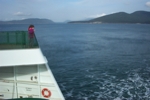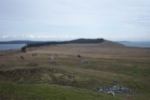Major fire next door, close to the intersection of 8th and Seneca, right now. More soon.
Insignificant Microbe
Jacqueline pointed out The Truth Laid Bear‘s Weblog Ecosystem, which ranks weblogs by how many links point to them. Similar to Technorati, really, as far as I can tell. Not that that’s a bad thing, of course…just something I noticed.
Of course, I had to sign up.
As I’m brand new to the system, I’m currently an “Insignificant Microbe“. In theory, after they do a scan and figure out how many other sites link to me, I could move up a bit…we’ll see how that goes.
iTunes: “This House is Cursed” by Altered Ego from the album Radikal Techno Vol. 2 (1992, 5:17).
Beating Internet Explorer into the 21st Century
I can hardly wait until this is finished enough for the ‘download’ link to be active: IE7, a hack to force IE into behaving like a modern browser.
This is an attempt to make Microsoft Internet Explorer more compliant when it comes to web standards.
Web developers are becoming increasingly frustrated at the lack of convergence of the major browser vendors. We need a level playing field!
CSS is a powerful technology. Many of it’s more advanced features go unused by web developers because of Explorer’s poor support of CSS standards.
IE7 provides support for most of the important CSS enhancements. A full list is available on the compatibility page.
About time someone figured out how to do this, since Microsoft doesn’t seem to want to bother…;)
iTunes: “You’re Gonna Get Yours” by Public Enemy from the album Yo! Bum Rush the Show (1987, 4:05).
Even startup pranks are harder in Windows
There used to be a stupid little prank you could play on unsuspecting Mac users (running System 8 or 9 — if I remember correctly, the required utility wasn’t included in previous systems). Normally, when you were done using the computer, you would choose Special > Shutdown… to turn the computer off. However, apparently too many people had difficulties with that, so Apple started including a small utility that lived in the Apple Menu called Shutdown that would…shut down the computer.
So, if you wanted to annoy someone and had a moment at their Mac when their back was turned, you could copy that Shutdown application from the Apple Menu Items folder into the Startup Items folder. Once that was done, every time they started up their computer, as the system went through the Startup Items, it’d find that program, and shut right down again. Simple, and wonderfully annoying.
Tonight, I found a similar prank for Windows XP in Tech TV’s ‘Best Computer Pranks Ever’, and was fairly amused to see how convoluted the process was to get the same result!
To recap — on the Mac:
- Open two windows, [System Drive]:System Folder:Apple Menu Items and [System Drive]:System Folder:Startup Items.
- Option-drag Shutdown from Apple Menu Items to Startup Items.
On Windows XP…
- Right-click the Start menu.
- Select Explore Users.
- Navigate to Programs > Startup.
- Right-click the file windows and select New > Shortcut.
- When the window pops up asking for the location, enter “
%windir%system32shutdown.exe -r -t 00“.
On the one hand, it’s “only” five steps versus two, and I could have broken the Mac list into three steps (by splitting the first step into two). But even beyond that, there’s that cute little text string that has to be typed in to get the program to execute correctly.
Okay, yeah. So maybe it’s a good thing that — at least in this one instance — it’s harder to annoy someone under Windows XP than under the Classic Mac OS. That doesn’t mean that it doesn’t amuse me, though.
iTunes: “Moon Over Greene County” by Zanes, Dan from the album Natural Born Killers (1993, 2:19).
Hanscom Family Gallery RSS feed
For those of you (if there are any, of course) that use an RSS newsreader and occasionally check into the Hanscom Family Photo Gallery, there is now an RSS feed available to notify you of updates, courtesy of the Gallery RSS Generator.
(via Lockergnome’s RSS Resource)
iTunes: “Television” by Rollins, Henry from the album Think Tank (1998, 12:42).
Romeo! Hey, doll! Where you at?
This makes me cringe just thinking about it…Shakespeare re-written in modern prose, as today’s kids can’t seem to comprehend it as it was originally written.
“Et tu, Brute?”
Not anymore.
“And you too, Brutus?” is what students read in a new genre of study guides that modernize the Elizabethan English found in “Julius Caesar” and other plays by William Shakespeare.
These guides move beyond the plot summaries found in other study aides by providing line-by-line translations in modern-day English.
Once barred from school, the new translations now are being used in classes across metro Atlanta.
Ugh.
Ugh, ugh, ugh.
Or, more appropriately, in the words of Isabella in Measure for Measure — “Thy sin’s not accidental, but a trade.”
Or even better, Falstaff, in Henry the Fourth, Part II — “You scullion! You rampallian! You fustilarian! I’ll tickle your catastrophe!”
Admittedly, I may be an odd case — after reading the abridged version of Les Misérables in high school, I fell so in love with the story that I went out and bought the full, unabridged version, and it’s remained one of my favorites ever since. So for me, hacking something up is bad enough…but re-writing it like this?
Truly a travesty.
The one possible good point I can see is if the kids are captivated enough by the stories that they may someday go out and find the original versions — but I don’t think I’ll be holding my breath on that count.
(via Ben Hammersley, with help from the Shakespearean Insult Generator)
iTunes: “I Hold a Prince” by Poems for Laila from the album La Fillette Triste (1991, 3:07).
Tori Amos: Tales of a Librarian
Tori Amos has a new “greatest hits” collection available at the iTunes Music Store called ‘A Tori Amos Collection — Tales of a Librarian‘. Normally, this wouldn’t be terribly interesting to me, as I already have a very large Tori collection, and therefore wouldn’t have much need for a compilation album. However, this one caught my eye for two reasons.
Firstly, there are two exclusive tracks included only if you purchase the full album through the iTMS: Putting the Damage On (Reconditioned) and Pretty Good Year (Live from Sound Check). Secondly, all of the songs have been ‘reworked’ or ‘reconditioned’, which made me curious.
So far, I’m fairly impressed with what I’ve heard. None of the new versions are entirely new — in fact, on some of them, the changes are so subtle as to be almost unnoticeable, and I was initially starting to wonder if they had simply used ‘reworked’ rather than ‘remastered’ as a term and had just re-issued the original tracks. However, there are some definite changes to the tracks, usually in the form of a few extra instruments here and there, an extra vocal track or harmony line…slight edits and additions that flesh out the tracks a bit more.
One noticeable exception to the rule is the ‘reworked’ version of Professional Widow, which actually appears to be an edit of Armand van Helden’s dance remix of the track!
Overall, it’s not a must-buy for most people, but for a collector or for someone (like me) who gets a kick out of listening to a track’s production, trying to identify how it was all assembled, the collection is definitely worth the download.
iTunes: “Professional Widow (Reworked)” by Amos, Tori from the album A Tori Amos Collection – Tales of a Librarian (2003, 3:47).
Seattle recognizes gay marriages!
Okay, so we’re not performing the ceremonies yet, but it’s a start. Mayor Greg Nickles issued an executive order today declaring that the City of Seattle will recognize gay marriages.
“Seattle has often been in the forefront of protecting all its citizens regardless of sexual orientation,” Nickels said at a news conference announcing the order. He also proposed an ordinance to extend protections for gay married couples throughout the city.
At the same time, six couples prepared to file suit to force the state to reconsider its discriminatory “Defense of Marriage Act” and allow them to marry.
The six couples here applied for and were denied marriage licenses Monday morning in King County, which includes Seattle. Ron Sims, who is the King County executive, a supporter of gay marriage and a candidate for governor, participated in a staged event encouraging the couples to sue him and other county officials. They did so, filing a challenge to Washington’s 1998 Defense of Marriage Act.
“I have always said I will follow the rule of law,” Mr. Sims said. “I will not issue licenses, but I thought it was appropriate to have a challenge through the court system.”
Lisa Stone, executive director of the Northwest Women’s Law Center, one of the legal groups representing the six couples in the suit, said she thought it was more effective to mount a legal challenge to the state law, rather than encourage city, county or state officials to issue marriage licenses in defiance of the law, only to have them legally challenged later.
iTunes: “Ocean Size” by Jane’s Addiction from the album Nothing’s Shocking (1988, 4:19).
The Pig War of San Juan Island
In the early 1800’s, as settlers moved westward across America, a dispute arose between the Americans and the British over ownership of the Oregon Country, land covering much of today’s Pacific Northwest, stretching from Oregon through Washington and up into British Columbia and parts of Idaho and Wyoming. While the territory had been declared to be in joint possession of the two governments, as more and more settlers moved in, the British claimed that land ceded to them in previous treaties and through the work of the Hudson’s Bay Company was being encroached upon.
After a few years of slightly strained tensions, in 1846 the Oregon Treaty peacefully resolved the dispute, setting the 49th parallel as the upper boundary of the United States. As the 49th parallel cuts directly through Vancouver Island when extended westward, it was determined that the boundary line would extend “to the middle of the channel which separates the continent from Vancouver’s Island; and thence southerly through the middle of the said channel, and of Fuca’s straits to the Pacific Ocean.” Unfortunately, that wording proved to be unclear enough to set the stage for another conflict.
The difficulty lay in that there were two straits running southward through the islands — Haro Strait and Rosario Strait. As each country wanted the most advantageous boundary line, each claimed that the boundary ran through whichever strait would grant them the islands, with the British running the boundary line through Rosario Strait and the Americans, Haro Strait.
Over the next few years, both the British and the Americans started utilizing San Juan Island, with each group assuming that the other group was there illegally. By 1859, the British Hudson’s Bay Company had both a salmon-curing station and a sheep ranch operating on the island, and the Americans had about eighteen settlers living there also. Tempers were short, but things didn’t come to a head until June of 1859.
On June 15 of that year, American settler Lyman Cutlar discovered a pig rutting through his garden. He shot and killed the pig — which belonged to his neighbor, an Irishman employed by the Hudson’s Bay Company. When Cutlar offered to pay for the pig, his neighbor claimed that the pig was a champion breeder and demanded $100 for the loss. Considering this high price to be unreasonable, Cutlar refused to pay. British authorities, already considering Cutlar and the rest of the settlers to be illegal squatters, threatened to arrest him. The American settlers, none to happy about these British who refused to leave their island, petitioned for U.S. military protection. On July 27th, a 66-man company of the 9th U.S. infantry, commanded by Cpt. George E. Pickett, landed on the southern tip of the island and set up camp.
The British governor of British Columbia’s Crown Colony, angered by the arrival of U.S. troops. answered by sending in his own forces — three British warships commanded by Cpt. Geoffrey Hornby — with instructions to remove Pickett from San Juan Island, but to avoid any actual hostilities if at all possible.
Over the next few months, each side continued to send in reinforcements, until by the end of August, “461 Americans, protected by 14 cannons and an earthen redoubt, were opposed by three British warships mounting 70 guns and carrying 2,140 men, including bluejackets (sailors), Royal Marines, artillerymen and sappers.”

Incidentally, the construction of the redoubt at the top of a hill in the American camp to let the cannon oversee the water approaches to the island was supervised by engineer Henry Martyn Robert. Later in his military career, Robert discovered a fascination with parliamentary procedure, and went on to author Robert’s Rules of Order.
Thankfully, throughout all of this territorial saber-rattling, saner heads prevailed, refusing to “involve two great nations in a war over a squabble about a pig,” in the words of British Rear Admiral Robert L. Baynes. Eventually, U.S. President James Buchanan dispatched General Winfield Scott to resolve the affair. Scott was able to broker a treaty, with each country reducing their forces — a single company of U.S. troops, and a single British warship — allowing the island to continue under joint occupation until a more formal resolution could be reached.
This situation continued for the next twelve years, making the Pig War the longest single military conflict on U.S. soil — even if the only casualty was a hungry pig. Eventually, during the signing of the Treaty of Washington between Britain and the United States, Kaiser Wilhelm I of Germany was asked to arbitrate in the matter of the San Juan Islands. He referred the matter to a commission, and after a year of deliberation, the commission ruled in favor of the United States on October 21st, 1872. British troops withdrew from San Juan Island within the month, and the last of the U.S. troops left by mid-1874.
Sources:
- National Park Service: The Pig War
- Todd Matthews: The Pig War of San Juan Island
- Rocky Mountain Books: Pig War on San Juan
- Discovery Inn: The famous Pig War and Other Adventures
- John Stang, Tri-City Herald: San Juan Islands overflow with adventure
San Juan Island: ducks and pigs
Back…finally!
The weekend was quite pleasant, though it ended up being a bit more adventurous and taking longer than we expected. Prairie and I got up really early on Saturday morning to drive out and catch the 9:30am ferry from Anacortes to Friday Harbor, San Juan Island, then continued on from there to our destination for the weekend.
Prairie’s dad’s fiancé owns and runs Wood Duck Ponds, a gorgeous vacation and wedding retreat almost smack-dab in the center of the island. The property includes two large houses that she rents out to visitors; three ponds that are home to various ducks, geese, and swans; lots of gardens that I’m sure are beautiful during the summer months when in full bloom; and plenty of space to wander around in.
One of the definite benefits to visiting in the “off season” (not to mention the family connection) was that we were able to stay in the larger of the two rental houses. The Bridge House is beautiful — five bedrooms, two living rooms, a fireplace, a hot tub on the outside deck, and huge windows overlooking the gardens and one of the ponds. The weather was too cold and rainy for us to take advantage of the hot tub, unfortunately, but a pleasant evening in front of the fireplace with a movie worked out quite nicely.
We were able to spend some time Saturday afternoon and Sunday morning exploring the island, with Prairie’s dad as something of a tour guide. Saturday we headed down to some national parkland at the southeastern tip of the island — a former American military encampment (called, ingeniously enough, the “American Camp”) from some conflict between America and Britain that I was told had something to do with a pig. Both Prairie and her dad kept making oblique references to the “pig incident”, however, neither of them could remember enough details about it to actually fill me in. I was assured, however, that there would be signs at the parkland that would make everything clear.
Sure enough, when we got to the site, there were signs scattered around that told the story. Unfortunately, as we ended up wandering rather aimlessly around the grounds after a wrong turn and spent most of our walk doing our best to avoid various nettles and thorny bushes, I was still a little lost as to just what went on with the pig. All told, the primary impression I got from the area was just how stupendously bad a job the American soldiers did of picking a place for their encampment — the entire area is rather barren, with little to no trees to block the wind that comes fairly constantly off the water, and what little harbor is there is far to shallow to allow ships to come up terribly close to land. All in all, it looked like a rather horrid little place to have to stay for any length of time.
Sunday we headed to the northwestern part of the island to check out the site of the other players in the “pig incident” — the British camp. While I did finally get the rest of the story while we were there (which will come along before terribly long…), I was rather amused at how handily the British troops had managed to one-up their American counterparts. Their encampment site was beautiful — a sheltered cove in the lee of the prevailing winds, with a decent deep-water harbor for their ships to dock in, hillsides for their barracks that overlooked the water, and they’d even planted an ornamental garden to beautify the site and remind their wives of home! Much, much nicer than what those poor American shmoes had to put up with!
I’ll get to the details of the “pig incident” in my next post. ;) Gotta keep y’all coming back somehow, after all!
I did discover one other interesting thing while I was on the island, though. Ever since I got down to Washington, I’d occasionally see one tree in the midst of a grove that had an unusual, bright red coloring to its trunk, but I’d never found anyone who knew what kind of tree it was, or why it had the coloring that it did. There were a couple of the trees on the Wood Duck Ponds property, though, and when I asked Prairie’s dad about it, he told me that they were Pacific Madrone trees. Apparently, the Madrone is known for its unusual coloring — the wood of the tree has a deep, rich red tone to it, and the tree will actually shed its bark at time, allowing the coloring of the inner wood to show through. Whatever the cause, they’re gorgeous, and now I at least know what I’m looking at!
Eventually, it was time to leave, and we headed out. The ferry ride from Friday Harbor to Anacortes was nice and uneventful, and we pulled over into a gas station in Burlington to fill the gas tank before we made the drive back to Seattle. Unfortunately, there disaster struck — Prairie’s car absolutely refused to start again. She’d suspected that it had been having some difficulty with the fuel lines a few months ago, but the mechanic she had taken it to at the time had assured her that everything was fine, and that there wasn’t a problem. Well, apparently he was more than a little wrong, as no matter how we threatened, coaxed, or cajoled it, the car refused to turn over.
Tired and more than a little frustrated, we managed to get ahold of Prairie’s sister Hope. Hope and her boyfriend Peter came out to rescue us, a tow truck was called, and the car is now sitting in a lot in Mt. Vernon, to be taken to a shop there tomorrow morning. Hope and Peter dropped Prairie and I off here at my apartment, and tomorrow Prairie will be taking a Greyhound bus back to Ellensburg, with arrangements for getting the car fixed in her dad’s hands, and plans for getting her back to the car to be determined later on.
So, while the weekend as a whole was quite good, the final few hours were more than a little frustrating. Still, we’re back safe and sound, and everything will work out one way or another eventually.
More on the “pig incident” tomorrow, after I’ve had time to rest for a night (assuming your Google-happy little fingers don’t go all a-searching in the meantime, satisfying your curiosity but totally spoiling my storytelling skills).
Until then, my favorite picture from the weekend…






